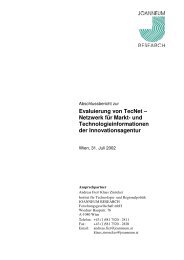roadMAP [PDF, 1.9 MB] - fteval
roadMAP [PDF, 1.9 MB] - fteval
roadMAP [PDF, 1.9 MB] - fteval
You also want an ePaper? Increase the reach of your titles
YUMPU automatically turns print PDFs into web optimized ePapers that Google loves.
Further necessary but no discriminating features for MAPs<br />
• Programme character: See definition of RTDI programmes, (Annex); namely the<br />
characteristics “public support of RTDI activities”, “existence of a structural framework”, “set<br />
of goals and rules (regularly in the form of funding guidelines”, “common umbrella” and<br />
“generally limited lifetime”). As MAPs are complex programmes, co-ordination issues are of<br />
special importance and in many cases an explicit, often external programme management is<br />
installed. As we talk about “RTDI funding programmes”, mere planning documents or<br />
strategy papers are not MAPs. The term “RTDI funding programme” also excludes<br />
institutions, which can run / manage MAPs but are not MAPs or programmes themselves.<br />
• Complexity: MAPs have a minimum level of complexity, resulting from the Multi Actor and<br />
the Multi Measure criteria described above. Therefore MAPs are always threatened by overcomplexity<br />
and role-conflicts. „Multi Goals“ is not necessarily an element of MAPs. Also note<br />
the strong interlinks between MAPs and the underlying institutional system. This point is not<br />
fully MAP-specific, but all MAPs show such an orientation.<br />
• Evaluations: ex ante, monitoring and ex post with a particular focus on MAP-specifics and<br />
effects are at least stated in the set of goals and rules. (MAP-specific evaluation and<br />
monitoring features are covered in chapter 6).<br />
Optional features of MAPs occurring in most of the programmes<br />
• Competitive bidding for funds and public calls: Funding is in most cases given only after<br />
a competitive selection procedure. Quite often a mixture between top-down and bottom-up<br />
takes place. This means very often free choice of topics and formation of consortia.<br />
• Two layers of “supporters”: MAPs are in most cases managed / implemented by an<br />
external programme management or an agency commissioned by a ministry or a comparable<br />
institution. There are MAPs where one institution or funding agency has all the relevant tools<br />
in hand, while within other MAPs different institutions or funding agencies grant different<br />
forms of support with different tools. Due to varying policy settings, the supporting structures<br />
can be highly distinctive: Sometimes a ministry has a very strong role also in operative<br />
matters, sometimes specialised agencies have clearly defined sub-tasks in a MAP etc. Note<br />
that this point is not fully MAP-specific, but nearly all MAPs show such features.<br />
• Specific learning elements and feedback loops: Due to the mentioned systems and Multi<br />
Actor approach most MAPs have some learning instruments.<br />
So the most important features are: Multi-measures on the level of performers,<br />
cooperation between Multi Actors from different worlds on the level of performers and<br />
addressing of innovation system problems as the main driving rationale (see also<br />
chapter 9)<br />
<strong>roadMAP</strong> 11


![roadMAP [PDF, 1.9 MB] - fteval](https://img.yumpu.com/21079876/16/500x640/roadmap-pdf-19-mb-fteval.jpg)

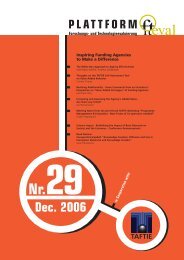
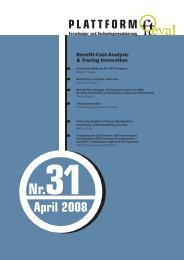
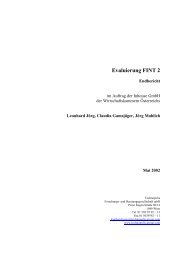
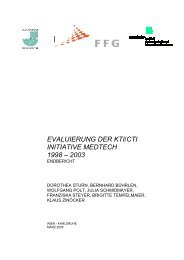
![GuggenbergeronBoku [PDF, 73.4 KB] - fteval](https://img.yumpu.com/21024081/1/184x260/guggenbergeronboku-pdf-734-kb-fteval.jpg?quality=85)
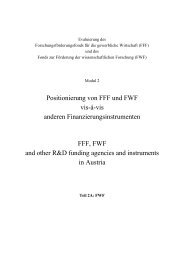

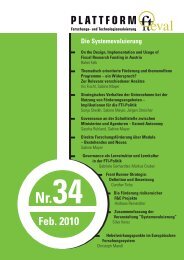
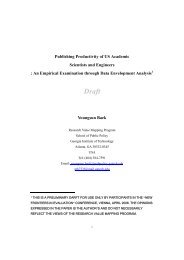
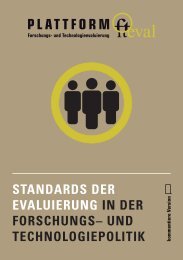
![ITF_Energietechnik [PDF, 39.6 KB] - fteval](https://img.yumpu.com/20959076/1/184x260/itf-energietechnik-pdf-396-kb-fteval.jpg?quality=85)
![Evaluation Standards [PDF, 120.8 KB] - fteval](https://img.yumpu.com/20931509/1/184x260/evaluation-standards-pdf-1208-kb-fteval.jpg?quality=85)
